Research Analysis: Caregiver Experience in Stroke Rehabilitation
VerifiedAdded on 2023/06/11
|6
|1721
|322
Essay
AI Summary
This essay provides a critical analysis of a research article focusing on the experiences of caregivers in the rehabilitation of stroke patients. It assesses the study's quality by examining the authors' credentials, the research purpose, study design, methodology, and results. The essay discusses the use of a mixed-methods approach, combining qualitative and quantitative research, and evaluates the rigour and validity of the research findings. It also explores the appropriateness of the sampling methods, data collection techniques, and statistical analysis used in the study. The analysis concludes by highlighting the theoretical and practical significance of the research and suggesting potential improvements for future studies, emphasizing the importance of understanding caregiver experiences in stroke rehabilitation to enhance patient-centered care.

Health Research
1
1
Paraphrase This Document
Need a fresh take? Get an instant paraphrase of this document with our AI Paraphraser
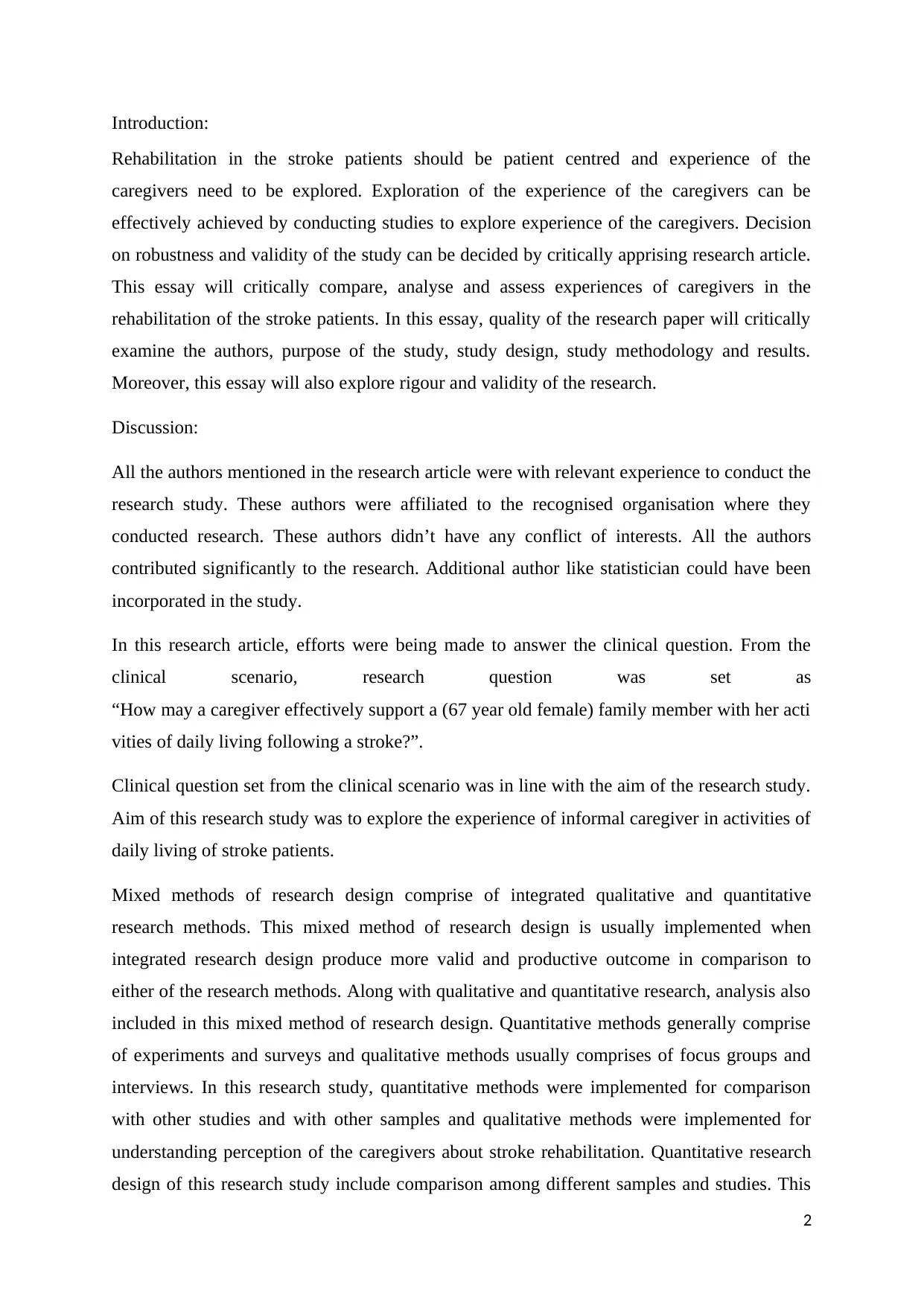
Introduction:
Rehabilitation in the stroke patients should be patient centred and experience of the
caregivers need to be explored. Exploration of the experience of the caregivers can be
effectively achieved by conducting studies to explore experience of the caregivers. Decision
on robustness and validity of the study can be decided by critically apprising research article.
This essay will critically compare, analyse and assess experiences of caregivers in the
rehabilitation of the stroke patients. In this essay, quality of the research paper will critically
examine the authors, purpose of the study, study design, study methodology and results.
Moreover, this essay will also explore rigour and validity of the research.
Discussion:
All the authors mentioned in the research article were with relevant experience to conduct the
research study. These authors were affiliated to the recognised organisation where they
conducted research. These authors didn’t have any conflict of interests. All the authors
contributed significantly to the research. Additional author like statistician could have been
incorporated in the study.
In this research article, efforts were being made to answer the clinical question. From the
clinical scenario, research question was set as
“How may a caregiver effectively support a (67 year old female) family member with her acti
vities of daily living following a stroke?”.
Clinical question set from the clinical scenario was in line with the aim of the research study.
Aim of this research study was to explore the experience of informal caregiver in activities of
daily living of stroke patients.
Mixed methods of research design comprise of integrated qualitative and quantitative
research methods. This mixed method of research design is usually implemented when
integrated research design produce more valid and productive outcome in comparison to
either of the research methods. Along with qualitative and quantitative research, analysis also
included in this mixed method of research design. Quantitative methods generally comprise
of experiments and surveys and qualitative methods usually comprises of focus groups and
interviews. In this research study, quantitative methods were implemented for comparison
with other studies and with other samples and qualitative methods were implemented for
understanding perception of the caregivers about stroke rehabilitation. Quantitative research
design of this research study include comparison among different samples and studies. This
2
Rehabilitation in the stroke patients should be patient centred and experience of the
caregivers need to be explored. Exploration of the experience of the caregivers can be
effectively achieved by conducting studies to explore experience of the caregivers. Decision
on robustness and validity of the study can be decided by critically apprising research article.
This essay will critically compare, analyse and assess experiences of caregivers in the
rehabilitation of the stroke patients. In this essay, quality of the research paper will critically
examine the authors, purpose of the study, study design, study methodology and results.
Moreover, this essay will also explore rigour and validity of the research.
Discussion:
All the authors mentioned in the research article were with relevant experience to conduct the
research study. These authors were affiliated to the recognised organisation where they
conducted research. These authors didn’t have any conflict of interests. All the authors
contributed significantly to the research. Additional author like statistician could have been
incorporated in the study.
In this research article, efforts were being made to answer the clinical question. From the
clinical scenario, research question was set as
“How may a caregiver effectively support a (67 year old female) family member with her acti
vities of daily living following a stroke?”.
Clinical question set from the clinical scenario was in line with the aim of the research study.
Aim of this research study was to explore the experience of informal caregiver in activities of
daily living of stroke patients.
Mixed methods of research design comprise of integrated qualitative and quantitative
research methods. This mixed method of research design is usually implemented when
integrated research design produce more valid and productive outcome in comparison to
either of the research methods. Along with qualitative and quantitative research, analysis also
included in this mixed method of research design. Quantitative methods generally comprise
of experiments and surveys and qualitative methods usually comprises of focus groups and
interviews. In this research study, quantitative methods were implemented for comparison
with other studies and with other samples and qualitative methods were implemented for
understanding perception of the caregivers about stroke rehabilitation. Quantitative research
design of this research study include comparison among different samples and studies. This
2
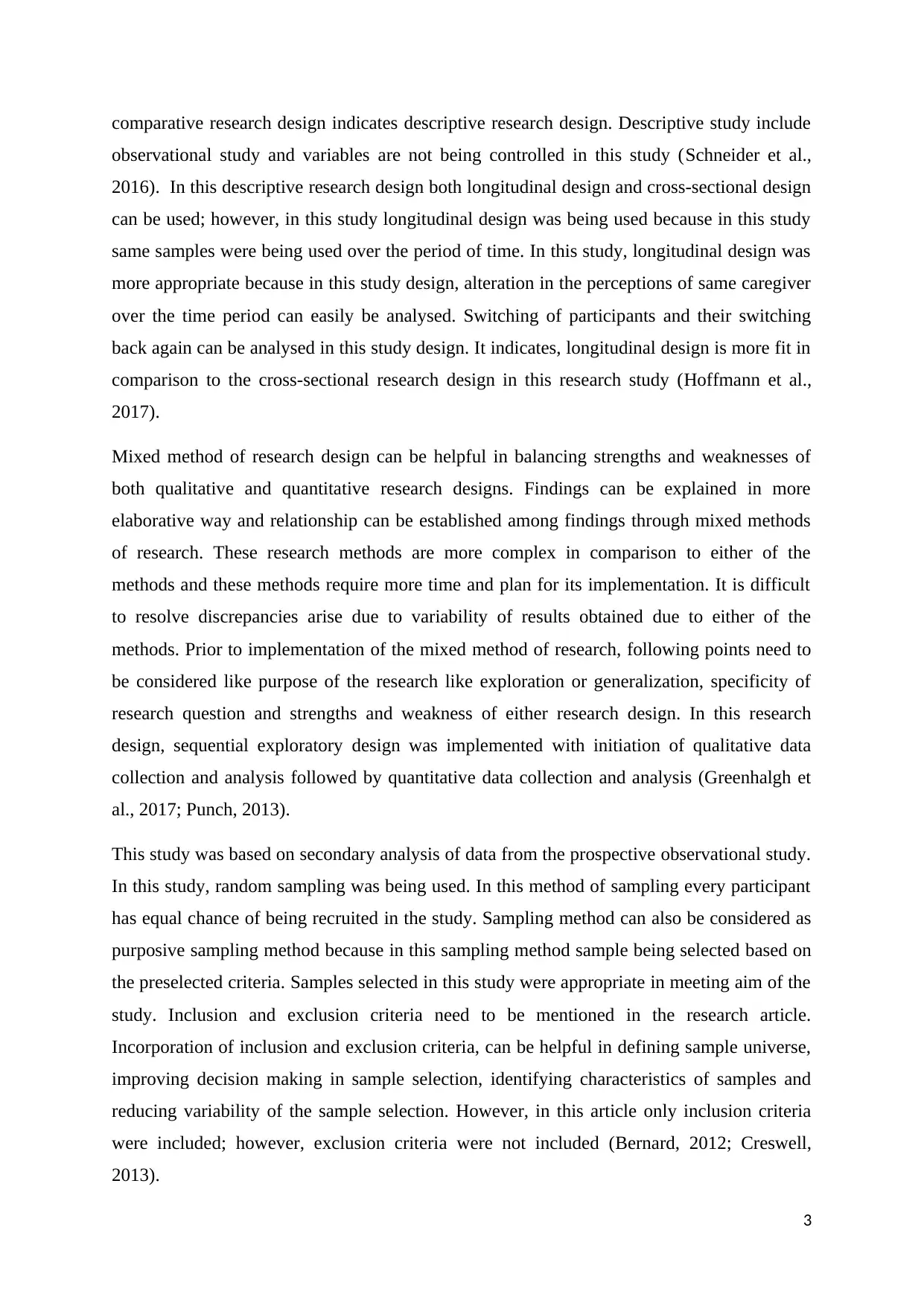
comparative research design indicates descriptive research design. Descriptive study include
observational study and variables are not being controlled in this study (Schneider et al.,
2016). In this descriptive research design both longitudinal design and cross-sectional design
can be used; however, in this study longitudinal design was being used because in this study
same samples were being used over the period of time. In this study, longitudinal design was
more appropriate because in this study design, alteration in the perceptions of same caregiver
over the time period can easily be analysed. Switching of participants and their switching
back again can be analysed in this study design. It indicates, longitudinal design is more fit in
comparison to the cross-sectional research design in this research study (Hoffmann et al.,
2017).
Mixed method of research design can be helpful in balancing strengths and weaknesses of
both qualitative and quantitative research designs. Findings can be explained in more
elaborative way and relationship can be established among findings through mixed methods
of research. These research methods are more complex in comparison to either of the
methods and these methods require more time and plan for its implementation. It is difficult
to resolve discrepancies arise due to variability of results obtained due to either of the
methods. Prior to implementation of the mixed method of research, following points need to
be considered like purpose of the research like exploration or generalization, specificity of
research question and strengths and weakness of either research design. In this research
design, sequential exploratory design was implemented with initiation of qualitative data
collection and analysis followed by quantitative data collection and analysis (Greenhalgh et
al., 2017; Punch, 2013).
This study was based on secondary analysis of data from the prospective observational study.
In this study, random sampling was being used. In this method of sampling every participant
has equal chance of being recruited in the study. Sampling method can also be considered as
purposive sampling method because in this sampling method sample being selected based on
the preselected criteria. Samples selected in this study were appropriate in meeting aim of the
study. Inclusion and exclusion criteria need to be mentioned in the research article.
Incorporation of inclusion and exclusion criteria, can be helpful in defining sample universe,
improving decision making in sample selection, identifying characteristics of samples and
reducing variability of the sample selection. However, in this article only inclusion criteria
were included; however, exclusion criteria were not included (Bernard, 2012; Creswell,
2013).
3
observational study and variables are not being controlled in this study (Schneider et al.,
2016). In this descriptive research design both longitudinal design and cross-sectional design
can be used; however, in this study longitudinal design was being used because in this study
same samples were being used over the period of time. In this study, longitudinal design was
more appropriate because in this study design, alteration in the perceptions of same caregiver
over the time period can easily be analysed. Switching of participants and their switching
back again can be analysed in this study design. It indicates, longitudinal design is more fit in
comparison to the cross-sectional research design in this research study (Hoffmann et al.,
2017).
Mixed method of research design can be helpful in balancing strengths and weaknesses of
both qualitative and quantitative research designs. Findings can be explained in more
elaborative way and relationship can be established among findings through mixed methods
of research. These research methods are more complex in comparison to either of the
methods and these methods require more time and plan for its implementation. It is difficult
to resolve discrepancies arise due to variability of results obtained due to either of the
methods. Prior to implementation of the mixed method of research, following points need to
be considered like purpose of the research like exploration or generalization, specificity of
research question and strengths and weakness of either research design. In this research
design, sequential exploratory design was implemented with initiation of qualitative data
collection and analysis followed by quantitative data collection and analysis (Greenhalgh et
al., 2017; Punch, 2013).
This study was based on secondary analysis of data from the prospective observational study.
In this study, random sampling was being used. In this method of sampling every participant
has equal chance of being recruited in the study. Sampling method can also be considered as
purposive sampling method because in this sampling method sample being selected based on
the preselected criteria. Samples selected in this study were appropriate in meeting aim of the
study. Inclusion and exclusion criteria need to be mentioned in the research article.
Incorporation of inclusion and exclusion criteria, can be helpful in defining sample universe,
improving decision making in sample selection, identifying characteristics of samples and
reducing variability of the sample selection. However, in this article only inclusion criteria
were included; however, exclusion criteria were not included (Bernard, 2012; Creswell,
2013).
3
⊘ This is a preview!⊘
Do you want full access?
Subscribe today to unlock all pages.

Trusted by 1+ million students worldwide
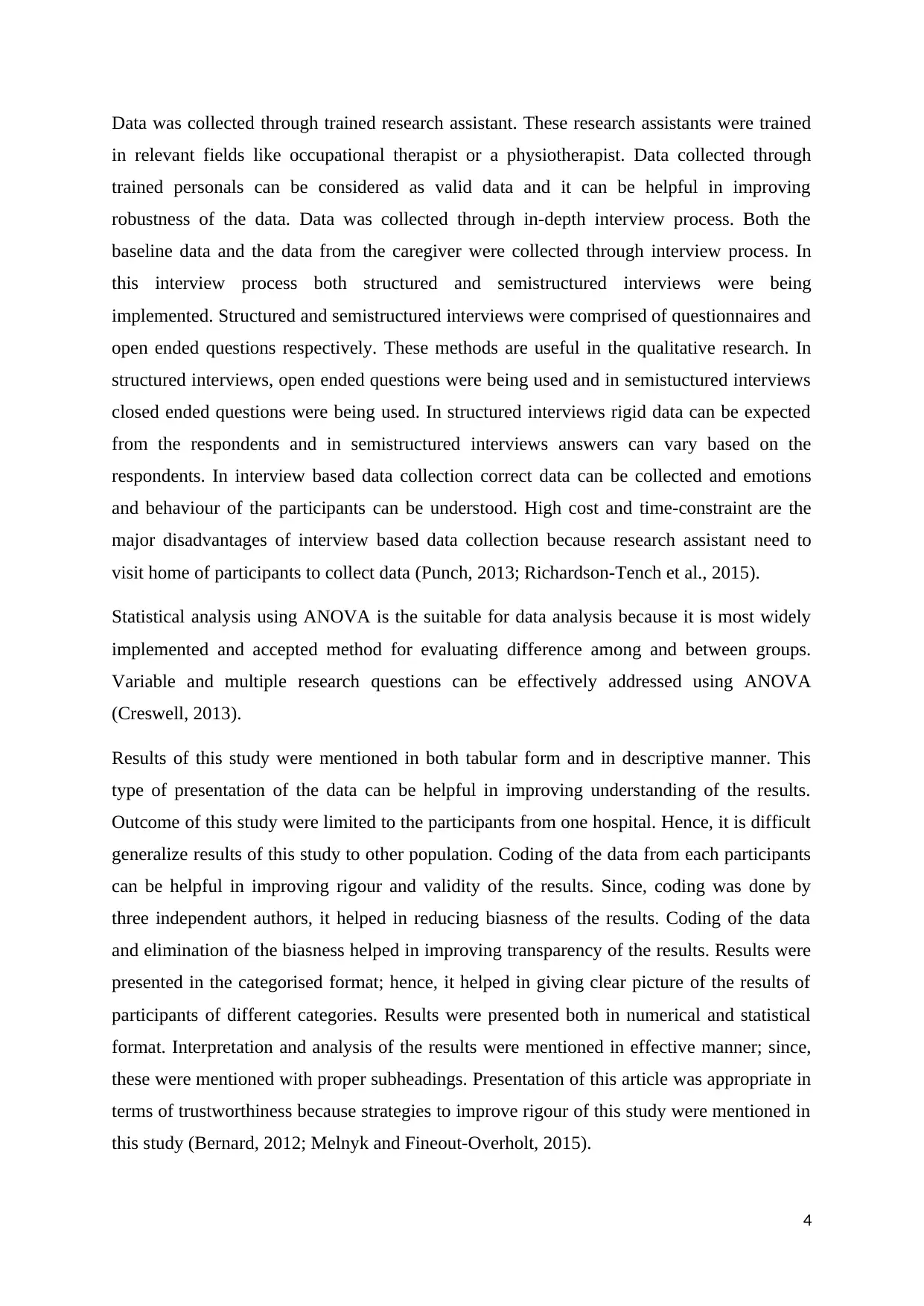
Data was collected through trained research assistant. These research assistants were trained
in relevant fields like occupational therapist or a physiotherapist. Data collected through
trained personals can be considered as valid data and it can be helpful in improving
robustness of the data. Data was collected through in-depth interview process. Both the
baseline data and the data from the caregiver were collected through interview process. In
this interview process both structured and semistructured interviews were being
implemented. Structured and semistructured interviews were comprised of questionnaires and
open ended questions respectively. These methods are useful in the qualitative research. In
structured interviews, open ended questions were being used and in semistuctured interviews
closed ended questions were being used. In structured interviews rigid data can be expected
from the respondents and in semistructured interviews answers can vary based on the
respondents. In interview based data collection correct data can be collected and emotions
and behaviour of the participants can be understood. High cost and time-constraint are the
major disadvantages of interview based data collection because research assistant need to
visit home of participants to collect data (Punch, 2013; Richardson-Tench et al., 2015).
Statistical analysis using ANOVA is the suitable for data analysis because it is most widely
implemented and accepted method for evaluating difference among and between groups.
Variable and multiple research questions can be effectively addressed using ANOVA
(Creswell, 2013).
Results of this study were mentioned in both tabular form and in descriptive manner. This
type of presentation of the data can be helpful in improving understanding of the results.
Outcome of this study were limited to the participants from one hospital. Hence, it is difficult
generalize results of this study to other population. Coding of the data from each participants
can be helpful in improving rigour and validity of the results. Since, coding was done by
three independent authors, it helped in reducing biasness of the results. Coding of the data
and elimination of the biasness helped in improving transparency of the results. Results were
presented in the categorised format; hence, it helped in giving clear picture of the results of
participants of different categories. Results were presented both in numerical and statistical
format. Interpretation and analysis of the results were mentioned in effective manner; since,
these were mentioned with proper subheadings. Presentation of this article was appropriate in
terms of trustworthiness because strategies to improve rigour of this study were mentioned in
this study (Bernard, 2012; Melnyk and Fineout-Overholt, 2015).
4
in relevant fields like occupational therapist or a physiotherapist. Data collected through
trained personals can be considered as valid data and it can be helpful in improving
robustness of the data. Data was collected through in-depth interview process. Both the
baseline data and the data from the caregiver were collected through interview process. In
this interview process both structured and semistructured interviews were being
implemented. Structured and semistructured interviews were comprised of questionnaires and
open ended questions respectively. These methods are useful in the qualitative research. In
structured interviews, open ended questions were being used and in semistuctured interviews
closed ended questions were being used. In structured interviews rigid data can be expected
from the respondents and in semistructured interviews answers can vary based on the
respondents. In interview based data collection correct data can be collected and emotions
and behaviour of the participants can be understood. High cost and time-constraint are the
major disadvantages of interview based data collection because research assistant need to
visit home of participants to collect data (Punch, 2013; Richardson-Tench et al., 2015).
Statistical analysis using ANOVA is the suitable for data analysis because it is most widely
implemented and accepted method for evaluating difference among and between groups.
Variable and multiple research questions can be effectively addressed using ANOVA
(Creswell, 2013).
Results of this study were mentioned in both tabular form and in descriptive manner. This
type of presentation of the data can be helpful in improving understanding of the results.
Outcome of this study were limited to the participants from one hospital. Hence, it is difficult
generalize results of this study to other population. Coding of the data from each participants
can be helpful in improving rigour and validity of the results. Since, coding was done by
three independent authors, it helped in reducing biasness of the results. Coding of the data
and elimination of the biasness helped in improving transparency of the results. Results were
presented in the categorised format; hence, it helped in giving clear picture of the results of
participants of different categories. Results were presented both in numerical and statistical
format. Interpretation and analysis of the results were mentioned in effective manner; since,
these were mentioned with proper subheadings. Presentation of this article was appropriate in
terms of trustworthiness because strategies to improve rigour of this study were mentioned in
this study (Bernard, 2012; Melnyk and Fineout-Overholt, 2015).
4
Paraphrase This Document
Need a fresh take? Get an instant paraphrase of this document with our AI Paraphraser
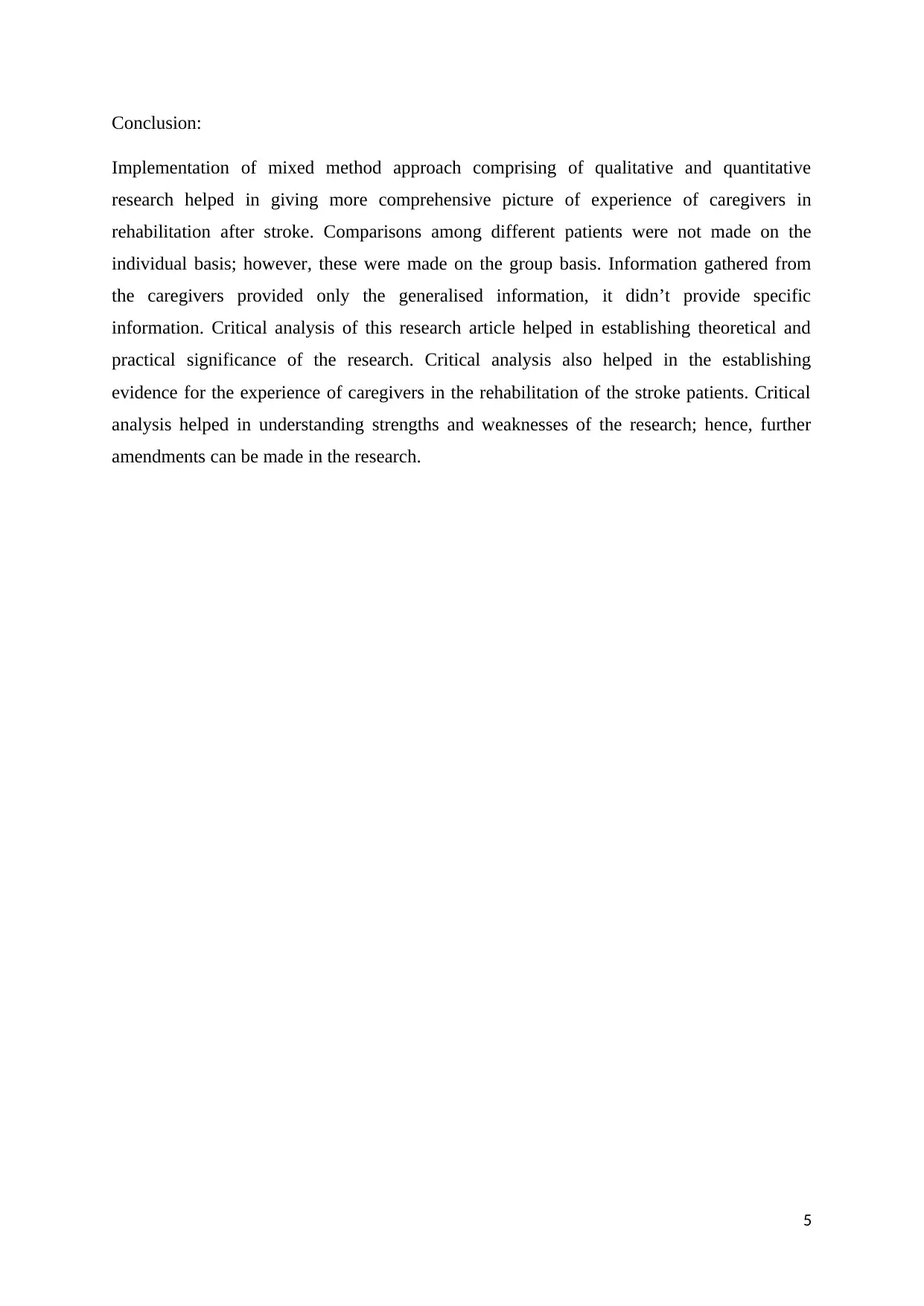
Conclusion:
Implementation of mixed method approach comprising of qualitative and quantitative
research helped in giving more comprehensive picture of experience of caregivers in
rehabilitation after stroke. Comparisons among different patients were not made on the
individual basis; however, these were made on the group basis. Information gathered from
the caregivers provided only the generalised information, it didn’t provide specific
information. Critical analysis of this research article helped in establishing theoretical and
practical significance of the research. Critical analysis also helped in the establishing
evidence for the experience of caregivers in the rehabilitation of the stroke patients. Critical
analysis helped in understanding strengths and weaknesses of the research; hence, further
amendments can be made in the research.
5
Implementation of mixed method approach comprising of qualitative and quantitative
research helped in giving more comprehensive picture of experience of caregivers in
rehabilitation after stroke. Comparisons among different patients were not made on the
individual basis; however, these were made on the group basis. Information gathered from
the caregivers provided only the generalised information, it didn’t provide specific
information. Critical analysis of this research article helped in establishing theoretical and
practical significance of the research. Critical analysis also helped in the establishing
evidence for the experience of caregivers in the rehabilitation of the stroke patients. Critical
analysis helped in understanding strengths and weaknesses of the research; hence, further
amendments can be made in the research.
5
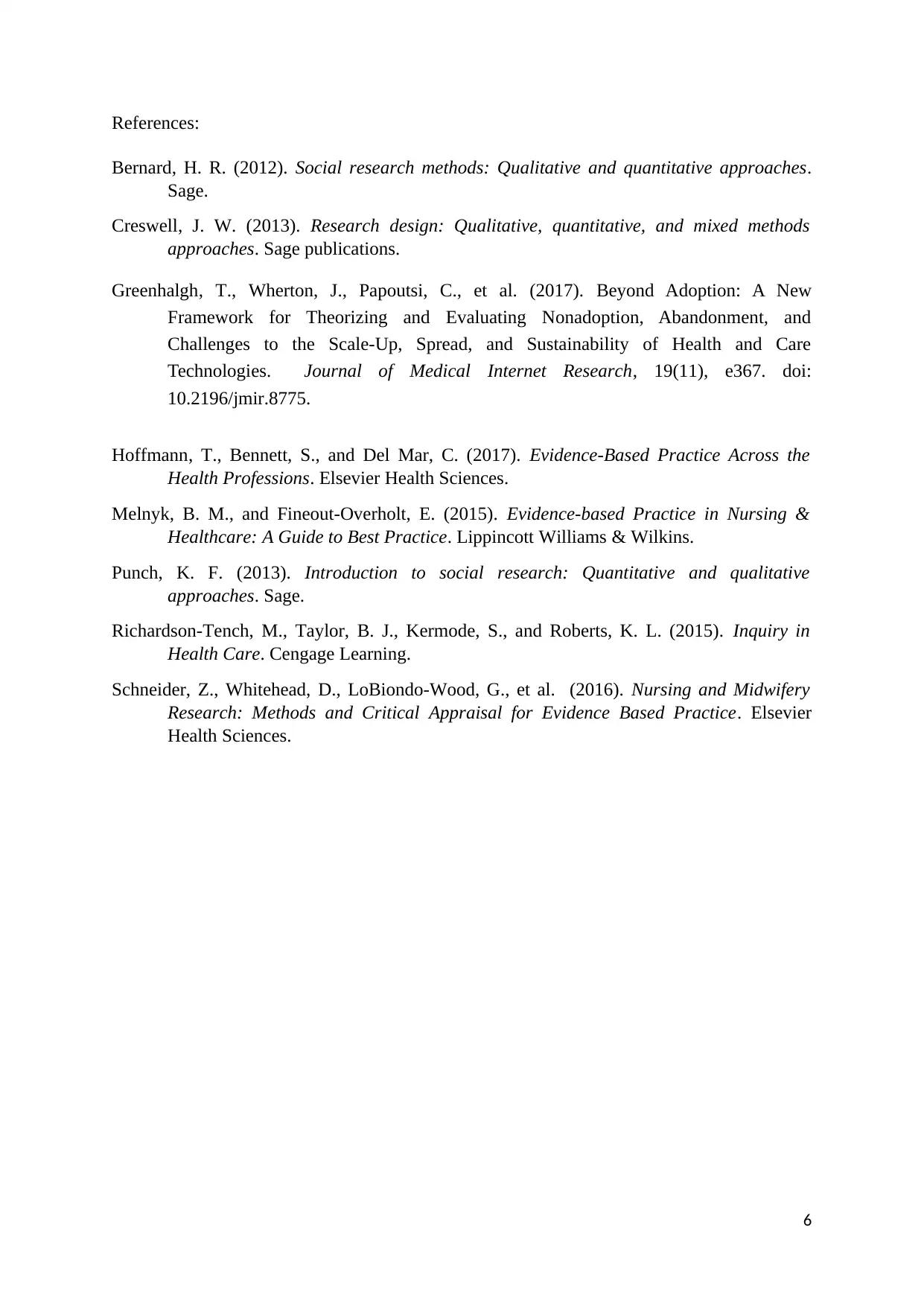
References:
Bernard, H. R. (2012). Social research methods: Qualitative and quantitative approaches.
Sage.
Creswell, J. W. (2013). Research design: Qualitative, quantitative, and mixed methods
approaches. Sage publications.
Greenhalgh, T., Wherton, J., Papoutsi, C., et al. (2017). Beyond Adoption: A New
Framework for Theorizing and Evaluating Nonadoption, Abandonment, and
Challenges to the Scale-Up, Spread, and Sustainability of Health and Care
Technologies. Journal of Medical Internet Research, 19(11), e367. doi:
10.2196/jmir.8775.
Hoffmann, T., Bennett, S., and Del Mar, C. (2017). Evidence-Based Practice Across the
Health Professions. Elsevier Health Sciences.
Melnyk, B. M., and Fineout-Overholt, E. (2015). Evidence-based Practice in Nursing &
Healthcare: A Guide to Best Practice. Lippincott Williams & Wilkins.
Punch, K. F. (2013). Introduction to social research: Quantitative and qualitative
approaches. Sage.
Richardson-Tench, M., Taylor, B. J., Kermode, S., and Roberts, K. L. (2015). Inquiry in
Health Care. Cengage Learning.
Schneider, Z., Whitehead, D., LoBiondo-Wood, G., et al. (2016). Nursing and Midwifery
Research: Methods and Critical Appraisal for Evidence Based Practice. Elsevier
Health Sciences.
6
Bernard, H. R. (2012). Social research methods: Qualitative and quantitative approaches.
Sage.
Creswell, J. W. (2013). Research design: Qualitative, quantitative, and mixed methods
approaches. Sage publications.
Greenhalgh, T., Wherton, J., Papoutsi, C., et al. (2017). Beyond Adoption: A New
Framework for Theorizing and Evaluating Nonadoption, Abandonment, and
Challenges to the Scale-Up, Spread, and Sustainability of Health and Care
Technologies. Journal of Medical Internet Research, 19(11), e367. doi:
10.2196/jmir.8775.
Hoffmann, T., Bennett, S., and Del Mar, C. (2017). Evidence-Based Practice Across the
Health Professions. Elsevier Health Sciences.
Melnyk, B. M., and Fineout-Overholt, E. (2015). Evidence-based Practice in Nursing &
Healthcare: A Guide to Best Practice. Lippincott Williams & Wilkins.
Punch, K. F. (2013). Introduction to social research: Quantitative and qualitative
approaches. Sage.
Richardson-Tench, M., Taylor, B. J., Kermode, S., and Roberts, K. L. (2015). Inquiry in
Health Care. Cengage Learning.
Schneider, Z., Whitehead, D., LoBiondo-Wood, G., et al. (2016). Nursing and Midwifery
Research: Methods and Critical Appraisal for Evidence Based Practice. Elsevier
Health Sciences.
6
⊘ This is a preview!⊘
Do you want full access?
Subscribe today to unlock all pages.

Trusted by 1+ million students worldwide
1 out of 6
Related Documents
Your All-in-One AI-Powered Toolkit for Academic Success.
+13062052269
info@desklib.com
Available 24*7 on WhatsApp / Email
![[object Object]](/_next/static/media/star-bottom.7253800d.svg)
Unlock your academic potential
Copyright © 2020–2025 A2Z Services. All Rights Reserved. Developed and managed by ZUCOL.




